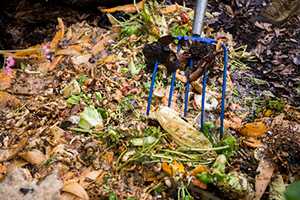Putting the Garden to Bed

It's hard to believe that the growing season is almost officially over. Unfortunately, with the end of the growing season, it's time to ensure we have set our gardens and flowerbeds up for success during the next growing season. Just a little time spent now can pay off big in terms of time and work in the spring.
Now is an excellent time to do a soil test and have the results you need to start the growing season. Fall is an excellent time to add some nutrients and work the garden to prepare for spring planting. Fall is also an excellent time to add organic matter to your soil and till it is in preparation for the spring season. It's easier to work the soil when it's dry than wait for it to dry in the spring. If you follow a no-till system, this is the perfect time to collect leaves and other organic materials or plant a cover crop to provide ground cover for your gardening spot next summer.
Be sure you are watering your landscape plants and lawn as needed so there is adequate moisture going into the winter, especially if it has been dry. If you planted any new trees or shrubs this fall, it is crucial to water them regularly since they have a limited root system. Even trees and shrubs planted within the last 2 to 3 years are more sensitive to drought than a well-established plant. Evergreens are also more at risk because moisture is lost from the foliage during the winter months. Trees or shrubs planted within the last year can be watered inexpensively with a 5-gallon bucket. Drill a small hole (1/8") in the side of the bucket near the bottom. Fill the bucket and let the water dribble slowly next to the tree. Refill the bucket once more, and you have applied 10 gallons. Large trees planted this year and transplanted two to three years ago will require more water. Soaker hoses are also an excellent option to water your flower beds or other areas. The hoses tend to water unevenly, but hooking both at the faucet can help prevent uneven watering.
It's time to think about mulching around perennials to help protect the crowns through the winter. As our roses go dormant this fall, it's time to start mounding soil or compost about 8 to 10 inches over the top of the plants to protect the crown during the winter. Mounding of Roses should be finished by Thanksgiving. After the ground has frozen, add a layer of mulch on top. It's best to wait to add the mulch till the ground freezes; otherwise, mice or other unwelcome critters might make a nest and eat the plants. Different plants, such as fall-blooming mums, should also be covered with much if you cut the stems back after they bloom. I usually wait to trim my perennial plants, except iris and peonies, because of disease issues until right before they start growing in the spring. This provides a habitat for small native bees to lay eggs or overwinter in, plus it helps protect the perennials from the extreme cold we had last winter.
As we hang up our gardening tools for the year, it is important to take care of them so they last for years. When we water the yard or landscape for the last time this fall, ensure your garden hose is drained and stored for the winter. This step should be done before a hard freeze to protect the hose and your faucet, and store your hose in an area out of direct sunlight to prolong its life.
Garden tools such as shovels, hoes, and rakes often have wooden handles that will slowly deteriorate due to exposure to sunlight, moisture, and other elements. This can easily lead to rough patches and splinters from our favorite tools. Keeping them stored inside when possible will slow this process; however, over time, the tools will still have some natural wear and tear. Take some time this winter to check the handles for splinters and sand down rough areas, then apply a protective coat (linseed oil, wood preservative, polyurethane, etc) to the handle to keep it protected. Don't forget about the metal part of the tool; make sure it's clean of dirt and debris, and apply a light amount of oil to prevent rust. Good tools are expensive, and a few minutes of work this fall can pay off big time for the future.

Have questions? Contact our office where our Horticulture Extension Agent will assist you with questions.
Phone: (316) 321-9660
Email: callae@ksu.edu